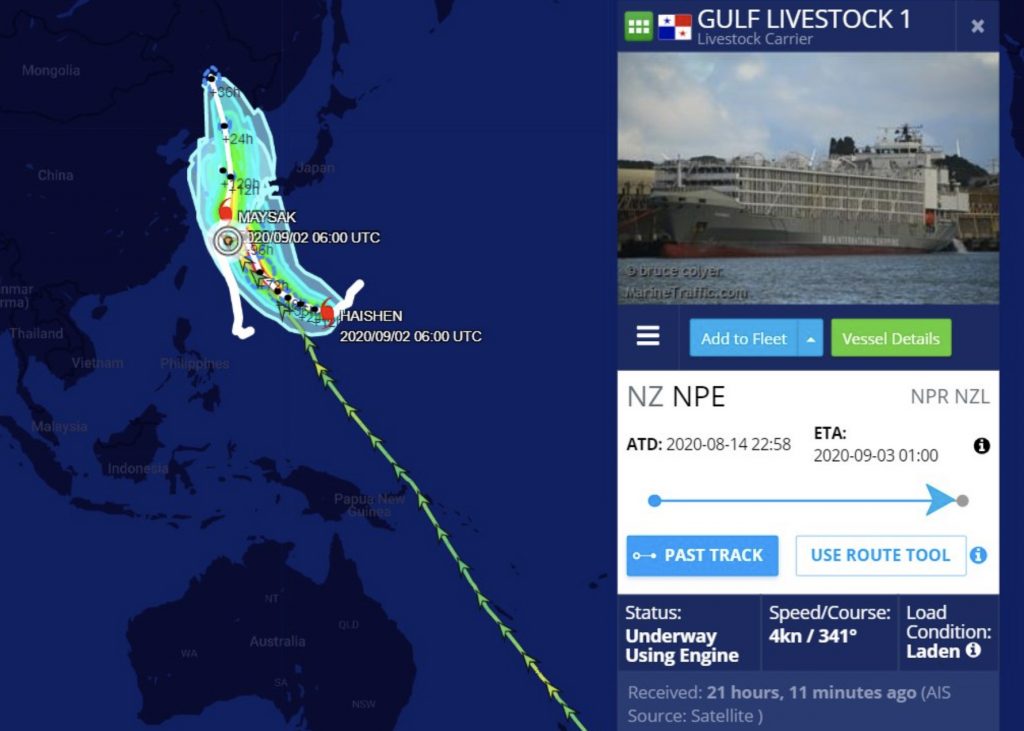
“Munhait hi nitaguwan tun ajor karu nga miid ahan chi iibba an tatagu ay mun-anap ay chi cha enggan adugwan.”
“It’s painful when the truth hits you, that nobody is looking for them until now,” said Maya Addug-Sanchez in Ilocano. Her brother, Captain Dante Addug, was one of the missing 36 Filipino crew on board the Gulf Livestock 1.
The Panama-flagged livestock carrier Gulf Livestock 1 capsized in southwest Japan a year ago, on Sept. 2, 2020, in the middle of typhoon Maysak, which was equivalent to a Category 4 hurricane with winds of at least 130 mph.
The 2002-built 133.6-meter-long (438 foot) ship had on board 39 Filipinos, two New Zealanders, and two Australians as crew, as well as 5,800 cattle.
The vessel left Napier, New Zealand, on August 14, 2020, and was sailing to Tangshan, China, when it experienced an engine issue and sent a distress signal before it went missing.
Two crew have been found alive so far, and another was pronounced dead on arrival at a Japanese hospital.
One of the survivors narrated that the ship’s main engine failed before the vessel was struck by a big wave and capsized.
A representative proceeding on behalf of Filipino, Australian, and New Zealand crew members has been commenced on Aug. 31, 2021, in the Admiralty and Maritime list of the Federal Court of Australia, seeking damages for certain crew members from the vessel owner and its charterers. The vessel owner and charterers have not yet filed a defense to the proceedings
Out of the families of 36 missing Filipino crew, only six joined the international case while most families have already received compensation for missing persons under the Collective Bargaining Agreement.
The nature and circumstances surrounding the work of seafarers onboard a vessel necessarily include the risk of accidental disappearance at sea. This risk is so peculiar to their employment that no other kind of employment is accompanied by the said risk.
In the absence of a CBA, employers usually attempt to evade liability for compensation for cases of missing persons involved in maritime accidents.
They argue that a person missing under the circumstances provided in Article 391 of the Civil Code may not legally be considered as dead until the lapse of the period fixed by law on presumption of death, and consequently the heirs cannot yet be considered as persons entitled to compensation under the law.

These include a person on board a vessel lost during a sea voyage who is missing, or a person who has been in danger of death under other circumstances and his existence has not been known for four years.
However, the Supreme Court ruled in Falcon Maritime, Inc., vs.. Flores (G.R. No. 202990, September 26, 2012) that these provisions do not apply if sufficient evidence exist that the person concerned had indeed died.
Where there are facts, known or knowable, from which a rational conclusion can be made, the presumption does not step in, and the rule of preponderance of evidence controls. (Joaquin vs. Navarro, 93 Phil. 257).
Witnesses narrated that when the deceased fell, it was still dark and the vessel was in the middle of the South Atlantic Ocean battling with strong winds and enormous waves.
There can be no other conclusion but that the deceased was struck and swallowed by the gigantic waves. He is no longer in danger of death pursuant to Art. 391 — he is already dead
In the case of Pantollano vs. Korphil Shipmgt. (G.R. No. 169575 March 30, 2011), the defense of prescription was raised in relation to a seafarer who went missing on August 2, 1994.
Korphil argued that the three-year prescriptive period commenced to run from the time the cause of action accrued, or at the time the seafarer allegedly died on August 2, 1994. Hence, when the wife filed her claim on May 29, 2000, the same has already prescribed.
The Court disregarded the defense of prescription as it ruled that on August 2, 1994, it cannot as yet be presumed that the seafarer is already dead.
If such an argument will be allowed, then no claim for death compensation benefits under this circumstance will ever prosper. This is so because the heirs of a missing seafarer have to wait for four years as provided under Article 391 of the Civil Code before he is declared as legally dead. After four years, the prescriptive period for filing money claims under Article 291 of the Labor Code would, obviously, lapse. This scenario could not have been the intention of the legislature in enacting a social legislation, such as the Labor Code.
“Hay waja lattan ha’in ya nan pammati’ hinan inkarin Ma’nongan nga aji na bay-bay-an nan tatagu na (What’s keeping me get by is my faith in the promise of God that He will not abandon His people),” said Maya.
The hashtag #SavetheForty is keeping the hopes of the relatives that they will soon receive news that the 40 men are still alive at sea and will be reunited with their families.
(Atty. Dennis Gorecho heads the seafarers’ division of the Sapalo Velez Bundang Bulilan law offices. For comments, email info@sapalovelez.com, or call 09175025808 or 09088665786.)
Source: Licas Philippines
0 Comments